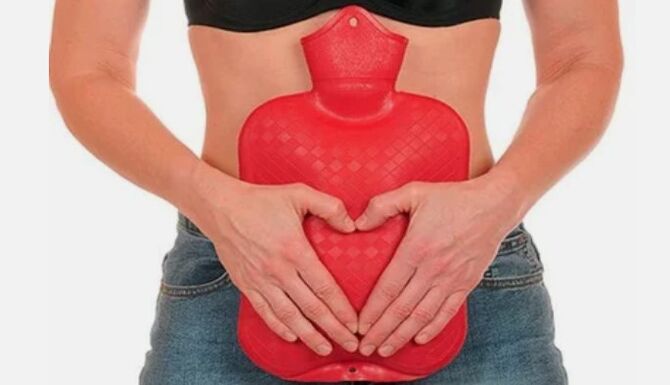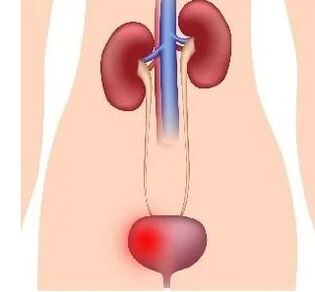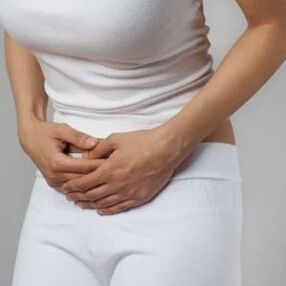Cystitite- This is a pathology characterized by the development of an inflammatory process that affects the bladder wall as a result of the effects of bacterial microorganisms.

Statistical cystitis- One of the most common urological pathologies. According to their morphophysiological properties, this inflammation is more prone to the formation.
Bacterial agents entering the mesder cavity are possible in three ways:
- Growing way- through urethra (urethra). The main role in this version of the reputation of microorganisms applies to the anatomical and morphological features of female urinary tract: a short and wide urethra, anus and vagina were closely distributed.
- Lowway- from kidneys. This option is developing in the progress of kidney inflammation, for example, chronic pyelonephrit.
- Hematogenic way- The rare option is based on the occurrence of cystitis immediately after infectious diseases or is found in the women's body when another source of infection is found. There is also a probability of bacterial microflora in the sac among the lymph veins of the lymphs of the lymphs of the lymphs of the gender and lymphs) in the above.
The most common cause of the bladder process is the agent E. Coli (above the above-mentioned anatomical and morphological properties and 5 jobs related to the intestine of this microflora).
Less, cystitis is associated with strektokok, streptococci and enteroccanic microorganisms. Gram -Negative rods lead to bladderin inflammation according to testing and surgical interventions.
Recently, the cysty of mushrooms, the cystitis related to microorganisms, the simplest and viruses increased.
Only the application of infectious microorganisms is not enough for the development of a full inflammatory response in the case, because the movement of the body's pathogeneous flora has resistance mechanisms.
Thus, in addition to an etiological factor, as follows
- Violation of hemodynamic functionPelvic bodies and especially bladder;
- Violation of the bladder function(urinary stagnation);
- Inhibition of various immune losses of the body(Vitamin deficiency, low temperature, stress, increased fatigue, etc. );
- Passional effects of biochemical substancesand products released in urine in urine in urine;
- exposure to radiological rays;
- Incomplacement with hygieneExternal sex and casual sex;
- Pathology of the gastrointestinal tract, the person who increases the activity of microflora and later entering the urinary tractor;
- Regular turns of hormonal metabolismThis leads to the lack of a tone of the urethra and creates the best conditions for the infection.

A woman is characterized by a sudden start and pronunciation symptom complex in a womanWith:
- Frequent urine (Polliolia) viewAt least 60 minutes and a small amount of urine released is characterized soon; Often patients can manage and maintain urine with the development of imperative challenges;
- Dysuria (urine violation)accompanied by pain in the hypogastric region (in the lower abdomen). With the development of an inflammatory degree in the wall of the bladder, these symptoms progress: more developments, the desire to give urine and more intense pain;
- Itching on urinary tractarises during the urinary act. Develops due to the exposure of microorganisms of microorganisms to the mucous membrane;
- The appearance of blood dropsAt the end of the urinary act;
- The appearance of the cloud of urine, a large number of blood cells (leukocytes and red blood cells), bacterial microflora, due to the cells of the surface epithel of the interior wall of the mesanitis;
- Such patients are not characterized by a change in general.The temperature indicators of patients are characterized by normal or slightly increasing (low level) numbers. Scientists should be associated with non-sucking microorganisms in the metabolic products of microorganisms of the microorganisms of microorganisms, which cause the development of the symptoms of inflammation.
The bodies of the sudden symptoms and women's body have been closed to the previous hypothermia. Acute inflammation occasion can sometimes be observed for 2-3 days and disappears independently without using therapy.

Nevertheless, in most cases, this process sometimes lasted more than 6 days. It then requires a disease to determine additional exam methods to determine the selected pathologies of the body, which is subject to the appointment of therapy.
Patients in acute cystitis are observed in a different degree of pain syndrome:
- In light of the inflamed process, patients feel insignificant violence or pain in the lower abdomen.At the end of the urinary act, sensitive pain accompanies mild polakuria. The intensity of pain increases with further development of inflammatory process. Subsequently, this syndrome accompanies the start or urinary act. The pain associated with pain is almost permanently, is constantly accompanied by a very painful palpation on the bladder's projection.
- Severe cystitis in a developedAt the end of additional pain syndrome and the act of the act, the actor is forced to urinate at least 2-3 times a clock with blood discharge. Pain significantly deteriorates the quality of the patient's life because they do not disappear in all days.
When a inflamed process in the walls of the bladder develops fabric areas near the performance of urethers and urethra. Tissue becomes empty and bleeding.
This shows itself in the end of the urinary act (terminal hemematia) in the uterine in the urine, which is often observed.
One of the most severe forms of acute cystitis is hemorrhagic. This year, the type of inflammation, red blood cells (red blood cells) significantly penetrated blood flow from blood flow to the bladder.
This option is possible in the increase in blood vessels (anemia, vitamin deficiency, blood system, ) or increasing the growing facility with the above walls (generally streptococonic flora). Red blood cells in the bloodstone in the bubble cavity.
When the hematy occurs, the doctor is obligated to carefully the differential diagnostics between acute cystitis and complex formation - hemorrhagic cystitis. To do this, additional exam methods are determined, the lesion type is clarified and the most accurate scheme of therapy is selected.
You can conclude the information above, the sharp start of the disease and a certain symptom complex for acute cystitis:
- Frequent urine in small parts,
- Pain syndrome in different nature,
- Itching with the act of urination,
- Blood drops at the end of the law,
- The unchanged general state of the woman.
Diagnosed with the correct and timely manner, the pathological situation is treated for 6-10 days. If there is no progress after the 15th day of the disease, it is worth thinking about the chronizes of inflammatory change.

In addition to hemorrhagic, there are two more forms of a complex course of a sharp cystitis:
- Winged.The ablast form is rarely found and occurs due to blood supply or sack innervation. Clinically, such a cystitis, pain, high body temperature indicates itself with difficulty accompanied by pain in the sacral region. The process is extremely dangerous for the development of giant complications such as peritonite and requires rapidly taken rapid measures for treatment.
- Flegmonous.PhleGmonous shape is significantly drunken in the body, itself with high body temperature and is accompanied by small amounts of urine (oliguria). Urine, such a complex current, a puddle-husband, muddy character, the flakes of fibrin formations, the blend of the blood.
In the event of developing complex forms, the duration of the pathological course is growing significantly.
There is another form of cystitis - the interstitial.All urine is characterized by inflammation of bubbling membranes. When filling in the bladder and regression in the clinic, filling the bladder and regression, while filling out the bladder and regression, active complaints of active complaints in the hypovastric region are prevailing active complaints in the urine area. Bubble's power is significantly reduced, resulting in the above symptoms.
Chronic cystitis, sharply, rarely, is a primary comprehension of pathology in most cases, the second-class complication of the existing pathologies of the bladder, kidneys and urethra.
Considering this fact, the fact that the body is the fact that the above pathological changes, as well as the concrete origin of microorganisms, should be ruled out or approve the occupation of the tuberculosis, trichomonas.
Clinical, chronic cystitis or urine with complaints and clinical analysis or in a pathological analysis of the urinity or a dueling pathological (in the form of a pathological process in the form of a pathological process).
Thus, the objective manifestations of the chronic cystitis are so suitable in a sharp process. The general protective properties of the body associate with a bacterial agent, a bacterial agent who has a bacterial agent and inflammation that causes a contagious process. Pain is less pronounced with a constant course, which is often urine, itching, blood and urine clouds, and compatible with a duplicate course of cystitis.
The lesion of the mucosa's inflamed counterfeit, the increase in all layers of the urined wall, and the increase in the intrapacear pressure, creates all conditions for the formation of vesicular-memorial reflux, i. E. Creates fluid from the pouch (combines kidneys and bubbles).

Doctor-Urologist is busy for the diagnosis and therapy for cystitis.
To properly diagnose inflammatory pathology, patients need to specify complaints and history (before the development of pathology).
Clinical manifestations are very specific and should immediately show the existence of this disease, but the differential diagnosis between all types of cystitis, as well as the differential diagnosis of other pathologies of abdominal organs.
Anamnesis will also be useful in localized stresses and effects of low temperature, medications, as well as localized in the system of pelvic bodies and geniourinary system.
After the complaint and the clarification of my mother, the clinical (general) urinary analysis will be able to help check the diagnosis - the growing level of white and red blood cells (corresponding to red blood cells, respectively).
To determine the type of bacterial microorganism, which causes inflammatory process, urine, sow special nutrients that can be used to choose the most effective antibacterial drug in the future.
Before the urine fence for the bacteriological examination, the territory of the external genital bodies should be treated in a quality with an antiseptic solution. When the incision reaction is shown, the cystoscopy is contraindicated.
In order to diagnose the chronic cystitis, the cystoscopy is in remission, along with the collection of complaints and information about Anamnesis. This will build all the necessary characteristics of an inflammatory disease. With this manipulation, it is possible to get biopsy material - urine bubble mucous membrane. It is also recommended to investigate an X -Ray research to determine the chronic cystitis.
























